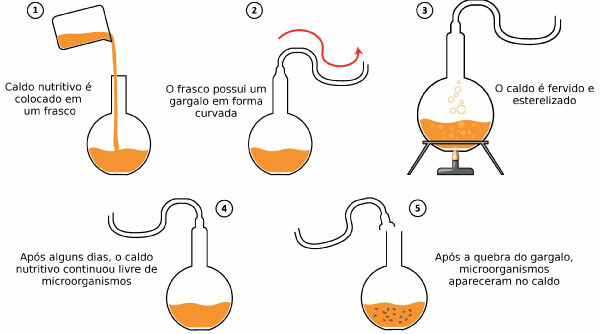for a long time to origin of life was an unknown and many scientists believed in the abiogenesis theory.
According to abiogenesis, living beings were the result of spontaneous generation from an active principle. This theory admitted, for example, that a mouse could emerge from a shirt soiled with human sweat along with a little wheat germ.
see more
Biology teacher fired after class on XX and XY chromosomes;…
Cannabidiol found in common plant in Brazil brings new perspective…
To prove this theory wrong, many scientists have tried to experiment and postulate theories, among them Redi and Pasteur.
the italian Francesco Redi (1626-1697) was an inquisitive physician and scientist. He was one of the first to hypothesize that the theory of abiogenesis was not correct.
Redi performed an experiment using some flasks, meat and gauze. He put a piece of meat in all the jars. One vial was tightly capped, another was left open, and another was covered with very thin gauze.
After some time, he observed that:
After this experiment, Francesco Redi concluded that life could only arise from other pre-existing life and had his hypothesis accepted by other scientists, thus creating the biogenesis theory.
From then on, abiogenesis began to lose credibility in the scientific community. However, the origin of microorganisms such as bacteria was still a mystery as scientists did not believe that such small beings could reproduce.

For almost 2 centuries, Redi's ideas were the only proven ones in the theory of biogenesis.
It was only in the mid-nineteenth century that Louis Pasteur (1822-1895), a French scientist, managed to definitively prove that all living beings, including microorganisms, originated from other living beings.
In 1860, the French Academy of Sciences offered a prize to whoever could prove the origin of microorganisms and it was then that Pasteur carried out his experiment.
He used glass flasks with stretched necks, some straight and others curved in a “swan neck” shape, so air could enter freely.
Pasteur created a nutritious broth made with water, sugar and fungus in suspension. He put some of the broth in each flask and boiled it until steam came out of the necks and all the microorganisms in the broth were dead. Then he left the vials to cool at room temperature.
After observing for a few days, Pasteur noticed that microorganisms had appeared in the nutritive broth in the flasks with a straight neck. In flasks with necks in the shape of a swan neck there was nothing, although they also had an available air inlet.
He then decided to break the neck of some flasks without contamination and noticed that after a few days they were also full of microorganisms in the broth.

This experiment showed that the organisms were present in the air and that, when they came into contact with the nutrient broth, they had an adequate medium to reproduce.
Flasks with a curved neck worked as a filter for microorganisms that were trapped in the curves and did not come into contact with the nutrient broth.
It was proved that, even being boiled, the broth still served as a source of nutrients for development of living beings, that is, he has not lost the "vital force" defended by the adepts of abiogenesis.
From then on, the theory of biogenesis was proven, completely burying the theory of abiogenesis.
Pasteur's experiments also brought many advances in medicine, as the principle of killing microorganisms raising the temperature began to be used in hospitals, drastically reducing the spread of infections.
Even today these principles are used in the food industry to remove microorganisms from food in a process called pasteurization.
Curiosity
Did you know that the original flasks from Pasteur's experiment, which had a curved neck and were not contaminated, can be seen at the Pasteur Institute in Paris? And, even after centuries, they still remain uncontaminated.
See too: